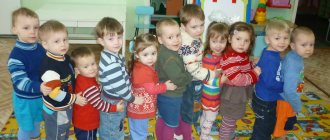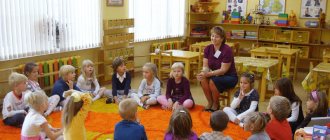Find the halves
For the game you need images of nesting dolls, divided transversely in half. The teacher lays out parts of the pictures in front of the player and asks him to assemble the toys into a single whole. It is important that the preschooler tries to combine the halves not only in size, but also in color and pattern on the apron.
For younger preschoolers, it is enough to take 2-3 pairs of parts; for students in the middle age group, you can increase the number of pictures.
Funny nesting dolls
For the musical game you need cardboard images of 5 nesting dolls of different sizes and colors. It is also necessary to give the players a pair of wooden musical spoons.
The music teacher places the pictures in a row in front of the children. Introduces the pupils to the dolls: Dashka, Sashka, Glashka, Irinka, Marinka. Explains that the guests love to dance. And the children need to play along with them on a folk musical instrument. Then he taps a different rhythm on the spoons for each nesting doll. And the children repeat. The teacher does not need to use spoons to demonstrate musical rhythm. You can play another instrument, and let the children play along with spoons.
A toy shop
Through the game intended for the older group, preschoolers learn about the matryoshka doll as an object of arts and crafts, learn to comprehensively and competently describe objects based on external features, and express and explain opinions. The lesson promotes the development of speech skills and concentration, and fosters a respectful attitude towards craft activities.
For the game you need to prepare images of nesting dolls with different types of painting. The teacher lays out the images on the “store counter”. One child becomes the seller, the rest of the players become buyers. The game consists of 3 stages:
- Each player takes turns taking the picture he likes and describing it in detail. You can’t repeat yourself when choosing a toy.
- The seller describes the picture. And buyers must guess what we are talking about.
- The player approaches the seller, describes the toy he wants to buy, but does not indicate it. The seller must guess which picture they want to buy from him.
Matryoshka travels
The game, intended for the older age group, reinforces mathematical concepts, teaches counting, quantitative comparative analysis, and spatial orientation. Children learn to compare objects by size, make verbal conclusions, and also indicate the position of objects using prepositions.
To play, you need to prepare an applique: paste an image of a river, a boat, a bridge, a tree, a berry bush, and flowers onto a cardboard sheet. Separately, you need to cut out the image of the nesting doll.
The matryoshka sets off on its journey: the children place its image near the river. At the same time, they explain in detail what they are doing. She is about to cross to the other side: the players drag the picture across the bridge. The matryoshka wanted to rest in the shade: the children put a picture under a tree. And under the tree there grows a bush with ripe berries. The doll looked at the tree, then at the bush, and thought what was higher: the students were doing a comparative analysis. Then I looked at the tree and the flowers around, and thought, what else is there: again, a comparative analysis. She counted how many flowers there were in the clearing - a lot. How many bushes - one. How many berries are ripe on it - a lot.
"Hen and Chicks"
Children, under the guidance of a teacher, place chairs at one end of the playroom. The number of chairs must correspond to the number of participants in the game. A cat driver is selected. The teacher acts as a mother chicken. The rest of the participants are her chicken children.
Mother hen invites all her chicks to join hands. Together they walk in a circle and say the following words:
A crested hen came out, Yellow chicks were with her, The hen clucked: ko-ko, Don’t go far.
The hen and chicks gradually approach the cat, sitting on a separate chair.
On a bench by the path a cat lay down and dozed. The cat opens its eyes and catches up with the chickens.
After these words, the chickens scatter, each trying to take his own chair. Mother chicken is worried about them, flapping her wings. The caught chicken becomes a cat. The game restarts from the beginning.
Matryoshka
The game, intended for middle preschool age, develops mathematical and speech skills and improves tactile perception. Its goal is to consolidate ideas about colors, sizes, spatial distribution, number of objects, expand thematic vocabulary, and develop the skill of answering questions competently. The activity promotes the development of fine motor skills and visual, in particular color, perception, and develops the skill of systematizing objects and distributing them by size.
To play, you need to make 7 nesting dolls, corresponding to the colors of the rainbow, with the image of a certain geometric figure on the apron. Each toy has a certain type of fastener: zipper, button, button, silk ribbon, lace, Velcro tape, buckle. You also need award chips and small decorative items: beads, rings, buttons, figurines, badges.
By playing with a red doll, a preschooler reinforces the idea of the number 1 and the square shape, and gains the skill of zipping up zippers. For the orange toy, the number 2, rectangle and button are relevant. For yellow - 3, circle, button. For green - 4, triangle, silk ribbon. For blue - 5, diamond, lace. For blue - 6, oval, Velcro tape. For purple - 7, polygon and buckle.
You can play with the presented material in different ways and come up with your own rules. The game can be individual or group. Here are some options:
- Make a series of nesting dolls according to the size and colors of the rainbow.
- Dress up the dolls using small decor in quantities corresponding to the number on the apron.
- The toys are in the correct order. The players close their eyes. The teacher hides the matryoshka doll. The pupils, opening their eyes, try to remember which toy has disappeared.
- The toys are arranged in the correct order. The students close their eyes. The teacher changes the location of the two toys. Opening their eyes, the players say what has changed.
For preschoolers of the younger group, it is advisable to place no more than 5 dolls in a row.
The player with the most chips for correctly completed tasks wins. If the game was individual, the player who completed the tasks should be encouraged.
"Carousel"
The players stand in a circle. There is a rope lying on the ground, forming a ring (the ends of the rope are tied). The guys pick it up from the ground and, holding it with their right (or left) hand, walk in a circle saying:
Barely, barely, barely The carousel spun, and then around, And then around and around, All running, running, running.
Children move slowly at first, and after the words “run” they run. At the leader’s command “Turn!” they quickly take the rope with their other hand and run in the opposite direction.
Hush, hush, don't rush! Stop the carousel. One and two, one and two, The game is over!
The movement of the carousel gradually slows down and stops with the last words. The players put the rope on the ground and run around the court.
Count the nesting dolls
The game is optimal for improving mathematical knowledge in middle school preschoolers and strengthening counting skills.
The teacher lays out nesting dolls of different sizes in random order. The child’s task is to put the toys in a row according to size - first from largest to smallest, then in reverse order, counting their number.
Running errands for a matryoshka
This active competitive game promotes general physical development and teaches one to navigate in space.
Children sit on chairs in a row. The teacher sits against the opposite wall, holding a matryoshka doll in his hands. Gives the command: “Here, to the nesting doll!” Children are running. The one who runs last loses. Then the teacher commands: “Now run back!” The children rush to their chairs. And so on several times until the winner is determined, who was the first to reach the toy more often than others.




